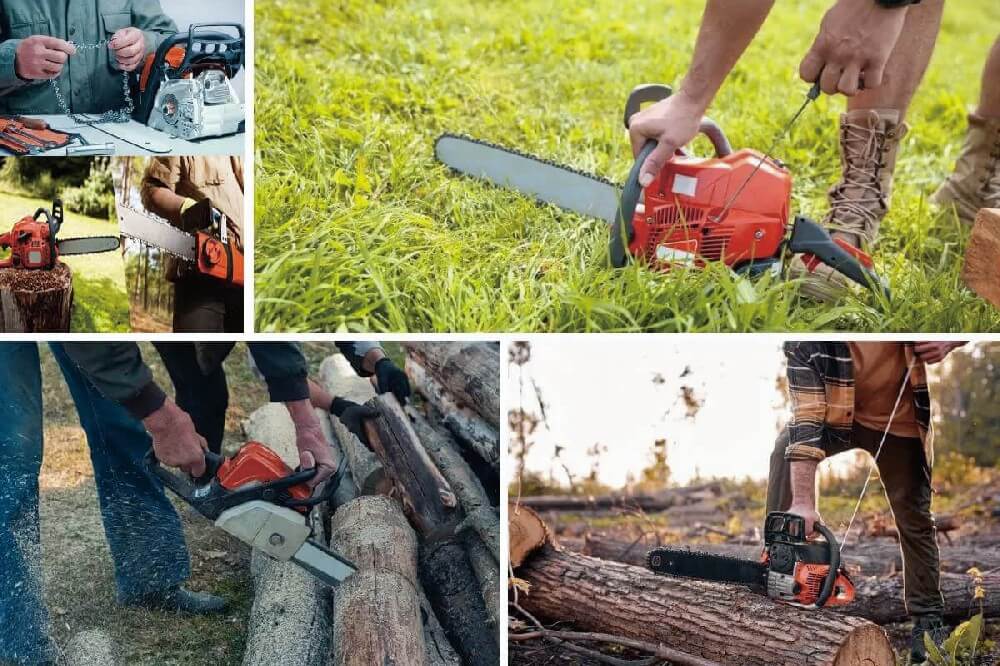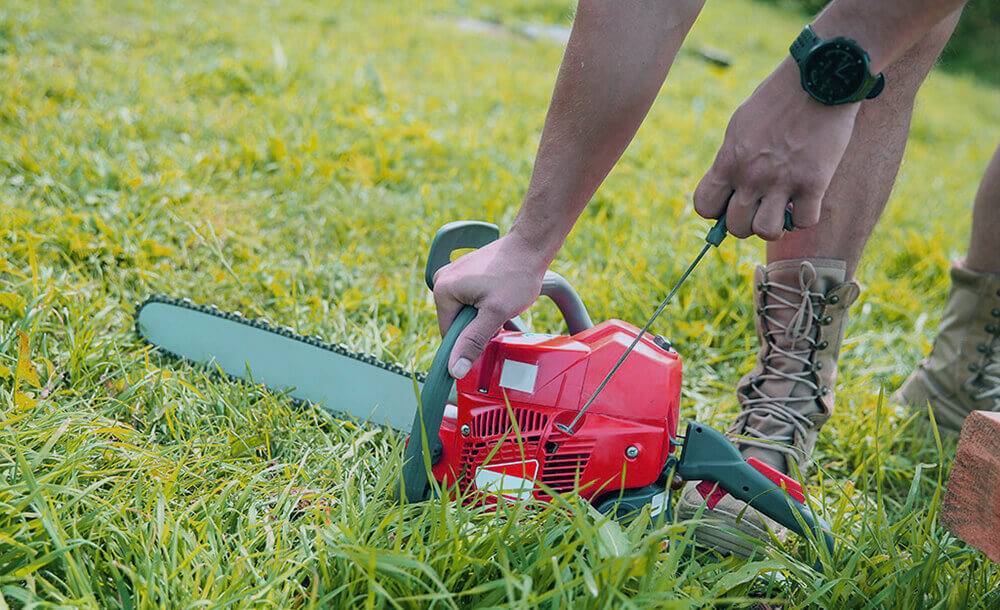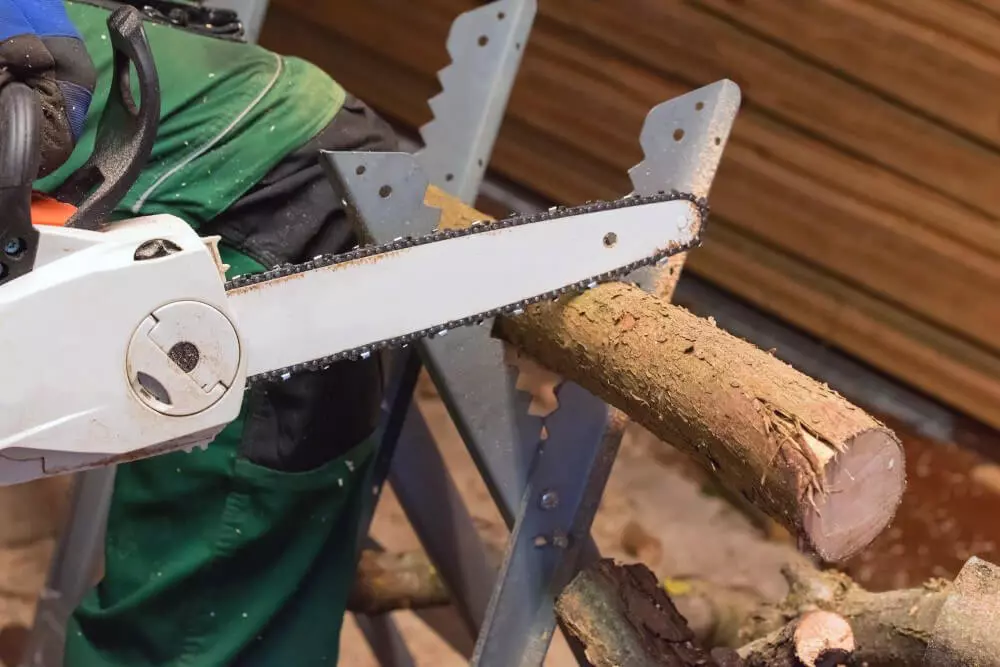22Apr 2023
table of contents

You may have encountered the problem of not being able to start power tools such as chain saws, especially when we use them for the first time.
Luckily, whether you're a first-time chainsaw owner or a veteran, whether you're using a gasoline chainsaw or electric chainsaw, and you need to start your chainsaw every time you try it for the first time, here's the guide you need.
Before you begin, make sure you are wearing proper protective gear such as shin guards, steel-toed boots, hearing protection, hard hat, gloves and, if necessary, goggles.
two starting positions
Stand on the back handle with your right foot and hold the front handle tightly with your left hand. Keep your left arm straight. Pulling the starter handle with the right hand will start the engine. Repeat until the engine fires.
Place the rear handle of the chainsaw between the left thigh and the back of the right knee. Grab the front handle with your left hand and hold it firmly in place. Make sure your left arm is straight.
An gasoline chainsaw is always easier to start when properly operated. BISON believes that performing a quick inspection is an essential first step before starting the gasoline chainsaw.
Check the oil level: If the two-stroke engine is filled with fresh fuel, make sure the spark plug boots are fully seated.

There are generally two ways to start a gasoline chainsaw: cold start and hot start.
When you start a cold chain saw, your goal is to get the fuel flowing and the saw's motor hot enough to ignite.
Step 1. Set up your chain brake
If the chain brake is not applied, the chainsaw chain will rotate around the bar once the engine is started. Setting up a chain gate is one of the most important security measures you can take.
Step 2. Close the choke
When you inject the engine with concentrated fuel, it starts easier. Closing the choke blocks airflow, which changes the mixture of air and fuel flowing to the engine, causing it to mix violently.
Step 3. Press the pressure reducing valve
Not all chainsaws have a pressure relief valve. If it is, press it right away, as it will reduce the pressure in the engine's combustion chamber, making it easier for the engine to fire. BISON provides some chainsaws with pressure reducing valves, welcome to consult.
Step 4. Press the primer bulb
Old chainsaws have primer bulbs. The primer bulb delivers fuel to the chainsaw's carburetor, which in turn delivers fuel and air to keep the engine running. Your saw only needs to push the primer bulb four to six times.
On newer saws, you're more likely to find air-purifying bulbs. Pressing down on this bulb will expel excess air from the fuel lines.
Step 5. Pull the starter rope
With the saw on the ground, place one hand on the handlebar and right foot on the trunk handle for stability, and slowly pull on the rope until you feel resistance. Then pull hard and quickly until the engine fires and you hear a pop or something like a cough. This is the sound your engine makes when it tries to start. The engine will not continue to run at this point, trust BISON, this is completely normal.
Step 6. Set the choke to "run" or "open"
Open the choke but keep the engine running at high idle. This adds air to the fuel mixture being fed to the engine, allowing it to run continuously without being flooded.
Step 7. Pull the wire again
The starter wire needs to be pulled several times until the engine sounds. Keep pulling until the saw starts; once it's done, it will keep running.
Step 8. Set the engine to "low idle",
Let the chainsaw run for a minute or so first. This will bring it to the ideal temperature for use. Then, depress the accelerator once and release to set the engine to low idle.
When you're ready to use the chainsaw, simply release the chain brake and go!
Hot start gasoline chainsaw means that you start it again after it has been used recently. The engine is still hot, so it will be easier for the spark plugs to reach the temperature they need to do their job.
So the big difference is that you don't have to keep the choke closed while the engine fires.
Step 1. Set up your chain brake
BISON believes this is a simple but often forgotten step, especially if your chainsaw was used earlier in the day. Always set the chain brake before starting the gas chainsaw.
Step 2. Close the throttle valve and set to "run" or "open"
Because your chainsaw is running all the time, it is already circulating fuel to the carburetor. Closing the choke is what sets the engine to "high idle". Moving the lever to the "run" or "on" position opens the choke but keeps the engine at high idle, which will allow the engine to run continuously.
Step 3. Press the pressure reducing valve
Even with a hot chainsaw, depressing the relief valve is still a useful step to relieve some of the pressure that has built up inside the carburetor.
Step 4. Pull the starter rope
As with a cold start, place the chainsaw firmly on flat ground. Pull the starter rope until the engine starts running.
Step 5. Set the engine to "low idle"
With a recently used chainsaw, you don't have to run the engine for a long time to warm it up. You can set the chainsaw to low idle and release the chain brake, and you're ready to start cutting.

First, for a cordless electric chainsaw, you'll want to use a fully charged battery, and for a corded electric chainsaw: plug the electric chainsaw into a grounded outlet, and choose an appropriate extension cord.
One of the advantages of the popularity of electric chainsaws is that starting them requires minimal effort. No need to open the throttle or pull the cord, just push or squeeze a few buttons. Importers are welcome to inquire about BISON electric chainsaws and select the appropriate cordless or corded electric chainsaw styles.
Step 1. Release the chain brake
Unlike gasoline chainsaw, where the chain continues to spin even when the engine is idling, the chain on electric chainsaw won't turn until you press the trigger. This means you need to release the chain brake on the electric chainsaw to start and spin.
Step 2. Press the safety button
Depending on the type of electric chainsaw you have, both cordless and corded electric chainsaws require you to press a safety lock button, which is used to prevent accidental activation, and its location and instructions for use will vary by the make and model of electric chainsaw. Usually this small button is located on the side of the rear handle. To reach the safety button on electric chainsaw, hold the handle with one hand and press the button with your thumb.
To engage the safety, depress the button with your thumb while pulling the switch trigger with your index finger. Release the safety button and continue to press the trigger switch to operate the electric chainsaw.
When starting your electric chainsaw, you may occasionally find that the motor doesn't work or won't start anymore. Some electric chainsaws with brushed motors can have issues causing the motor to stop working. Replacing the brushes will fix this problem and get your saw running again. Alternatively, you can look for a chainsaw with a brushless motor when choosing a corded electric chainsaw, Send Inquiry for BISON brushless motor electric chainsaw.
Whether you have a gasoline chainsaw, a cordless electric chainsaw, or corded electric chainsaw, BISON believes that by learning the above, starting your model will be a quick and easy task.
Ready to add a chainsaw to your shopping list? Consult BISON chainsaw suppliers online to understand!
inquiry form here
BISON BLOG, All the latest news and views from Bison Machinery.
Related Articles
How to Start a ChainsawRelated Products